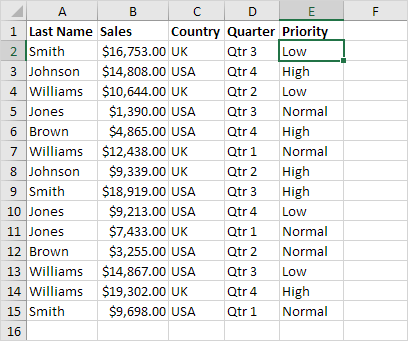5 Easy Steps to Sort Excel Sheets by Column

Sorting data in Excel sheets is a fundamental skill that can significantly enhance your productivity and data analysis capabilities. Whether you're sorting inventory lists, financial data, or employee records, organizing information in a meaningful order can help you make better decisions and find the information you need quickly. Here's a detailed guide on sorting Excel sheets by column in five simple steps.
Step 1: Open Your Excel Sheet

Before sorting, ensure that your Excel workbook is open and the sheet with the data you want to sort is active. If you have multiple sheets or tabs, select the one you wish to work with by clicking on its name at the bottom of the Excel window.
🚦 Note: Make sure to save your work before performing sort operations, as sorting can alter the data arrangement.
Step 2: Select Your Data Range

Decide whether you want to sort the entire sheet or just a specific range of cells:
- Sort Entire Sheet: Click the triangle in the top-left corner of your sheet, where column letters and row numbers meet. This will highlight all the data on the sheet.
- Sort Specific Range: Drag your mouse to select the cells you want to sort or click the first cell of your data range and then press Ctrl + Shift + Arrow to extend the selection until you reach the last cell with data.
⚠️ Note: Sorting the entire sheet might inadvertently include data you don’t want to sort, so be cautious when selecting your data range.
Step 3: Initiate the Sort Operation

With your data range selected, follow these steps:
- Go to the ‘Data’ tab on the Excel ribbon.
- Click on ‘Sort & Filter’.
- Choose ‘Sort A to Z’ or ‘Sort Z to A’ for a simple one-column sort, or ‘Custom Sort’ for more complex sorting.
Choosing ‘Custom Sort’ opens the ‘Sort’ dialog box where you can configure your sort parameters:
- Column: Select the column you wish to sort by from the drop-down list.
- Sort On: Here, you can choose between sorting based on Cell Values, Cell Color, Font Color, or Cell Icon.
- Order: Define whether the sort should be ascending (A to Z) or descending (Z to A).
📝 Note: If sorting by multiple columns, you can add levels in the ‘Sort’ dialog by clicking ‘Add Level’.
Step 4: Configure Advanced Sorting Options

Advanced sorting options can be accessed if you need to:
- Sort by multiple columns (Multi-level Sort).
- Sort by color or icon.
- Use a custom list for sorting (e.g., to sort weekdays from Monday to Friday).
You can also:
- Sort by Row: Although less common, sorting data horizontally by rows is also possible.
- Sort Options: Click on ‘Options’ to set case sensitivity or to sort numbers or dates stored as text.
🔍 Note: Multi-level sorting is useful when you want to organize data hierarchically, like sorting by product type first, then by sales amount.
Step 5: Apply and Review Your Sort

After setting your sort parameters:
- Press ‘OK’ or ‘Sort’ to apply the sort operation.
- Inspect your data to ensure it’s sorted correctly. If something looks off, you can undo the sort and tweak your settings.
| Issue | Possible Solution |
|---|---|
| Rows are not sorted as expected | Check for hidden rows, merged cells, or data mismatches. |
| Data loss after sorting | Make sure you have backups or the ability to undo changes. |
| Sorting affects headers | Include headers in your sort range or sort with headers excluded. |

⚡ Note: When sorting with headers, ensure you check the ‘My data has headers’ option to prevent header rows from being included in the sort operation.
The process of sorting Excel sheets by column is straightforward once you understand the steps. By properly selecting your data range, setting your sort criteria, and reviewing the results, you can efficiently organize your data to improve visibility and decision-making. Remember, while Excel's sorting capabilities are powerful, always ensure your data is backed up to avoid any unintended changes to your dataset.
Can I sort data by multiple columns?

+
Yes, Excel allows you to sort by multiple columns using a feature called multi-level sorting. You can add levels in the ‘Sort’ dialog box to define the priority of each column in the sort operation.
What happens if my data range includes headers?

+
If you select a range with headers, Excel can be instructed to treat the first row as headers by checking ‘My data has headers’. This prevents the headers from being included in the sort operation.
Is it possible to undo a sort operation?

+
Yes, you can undo a sort operation by using ‘Undo’ (Ctrl + Z), but ensure you do this immediately after sorting to avoid any subsequent changes being undone.
How does Excel handle sorting by color or icon?

+
Excel can sort cells by color or icon if you use the ‘Sort On’ option in the ‘Sort’ dialog box to choose sorting by Cell Color, Font Color, or Cell Icon. You can then specify the order of appearance for each color or icon.
Can I sort by a custom list?

+
Yes, you can sort by a custom list if you go to ‘Sort Options’ and select ‘Sort left to right’. This allows you to define your own sorting sequence, like sorting days of the week in a specific order.